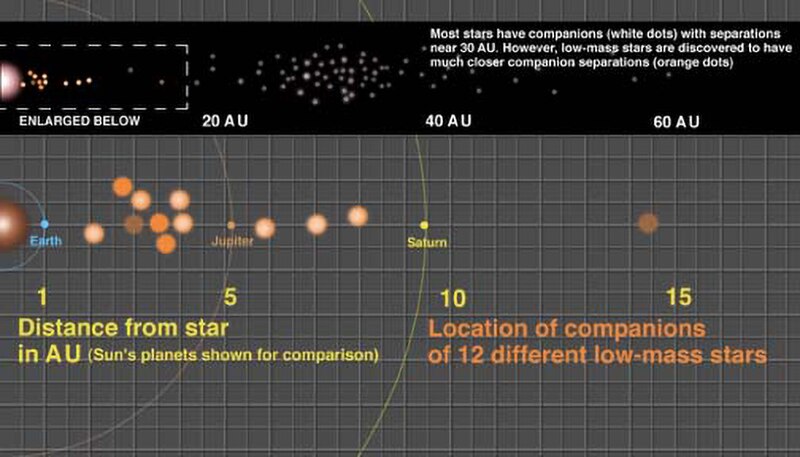File:Companion Distances From Low-Mass Stars (gemini0205b).tiff
From Wikimedia Commons, the free media repository
Jump to navigation
Jump to search

Size of this JPG preview of this TIF file: 800 × 457 pixels. Other resolutions: 320 × 183 pixels | 640 × 366 pixels | 992 × 567 pixels.
Original file (992 × 567 pixels, file size: 711 KB, MIME type: image/tiff)
File information
Structured data
Captions
Captions
This illustration shows the relatively small separations of the 12 companions found around low-mass stars that were studied in the Gemini Observatory survey by Laird Close et al.
Summary
[edit]| DescriptionCompanion Distances From Low-Mass Stars (gemini0205b).tiff |
English: This illustration shows the relatively small separations of the 12 companions found around low-mass stars that were studied in the Gemini Observatory survey by Laird Close et al. The wide view at the top shows the common distances for companions around larger "parent" stars (white dots), with the low-mass companions (orange dots) enlarged in the lower part of the illustration and a scale of our solar system drawn in for comparison. The fainter orange companions are brown dwarfs; the brightest are likely low-mass stars. Two gridlines equals one Astronomical Unit or the average distance between the Earth and the Sun (approximately 150,000,000 km or 93,000,000 miles.) |
| Date | 21 May 2002 (upload date) |
| Source | Companion Distances From Low-Mass Stars |
| Author | Gemini Observatory/NSF/AURA/J. Lomberg |
| Other versions |
|
Licensing
[edit]This media was created by the National Optical-Infrared Astronomy Research Laboratory (NOIRLab).
Their website states: "Unless specifically noted, the images, videos, and music distributed on the public NOIRLab website, along with the texts of press releases, announcements, images of the week and captions; are licensed under a Creative Commons Attribution 4.0 International License, and may on a non-exclusive basis be reproduced without fee provided the credit is clear and visible." To the uploader: You must provide a link (URL) to the original file and the authorship information if available. | |
This file is licensed under the Creative Commons Attribution 4.0 International license.
| |
File history
Click on a date/time to view the file as it appeared at that time.
| Date/Time | Thumbnail | Dimensions | User | Comment | |
|---|---|---|---|---|---|
| current | 21:41, 27 October 2023 |  | 992 × 567 (711 KB) | OptimusPrimeBot (talk | contribs) | #Spacemedia - Upload of https://noirlab.edu/public/media/archives/images/original/gemini0205b.tif via Commons:Spacemedia |
You cannot overwrite this file.
File usage on Commons
The following page uses this file:
Metadata
This file contains additional information such as Exif metadata which may have been added by the digital camera, scanner, or software program used to create or digitize it. If the file has been modified from its original state, some details such as the timestamp may not fully reflect those of the original file. The timestamp is only as accurate as the clock in the camera, and it may be completely wrong.
| Image title | This illustration shows the relatively small separations of the 12 companions found around low-mass stars that were studied in the Gemini Observatory survey by Laird Close et al. The wide view at the top shows the common distances for companions around larger "parent" stars (white dots), with the low-mass companions (orange dots) enlarged in the lower part of the illustration and a scale of our solar system drawn in for comparison. The fainter orange companions are brown dwarfs; the brightest are likely low-mass stars. Two gridlines equals one Astronomical Unit or the average distance between the Earth and the Sun (approximately 150,000,000 km or 93,000,000 miles.) |
|---|---|
| Width | 992 px |
| Height | 567 px |
| Bits per component |
|
| Compression scheme | LZW |
| Pixel composition | RGB |
| Orientation | Normal |
| Number of components | 3 |
| Number of rows per strip | 88 |
| Horizontal resolution | 72 dpi |
| Vertical resolution | 72 dpi |
| Data arrangement | chunky format |
| Software used | Adobe Photoshop 21.1 (Windows) |
| File change date and time | 15:47, 7 June 2020 |
| Exif version | 2.31 |
| Color space | Uncalibrated |

